Water Pollution: Causes, Effects, Global Efforts and Challenges
VerifiedAdded on 2021/11/16
|8
|3174
|144
Essay
AI Summary
This essay by Muhammad Amir bin Aziz provides a comprehensive overview of water pollution, defining it as the contamination of water bodies, making them unsafe for various uses and harming aquatic ecosystems. The essay explores the causes, including human activities like industrial waste disposal, sewage, urbanization, deforestation, and agricultural practices. It also examines the effects of water pollution on both the environment, damaging biodiversity and aquatic ecosystems, and on human health, leading to diseases like diarrhea and cholera. The essay further discusses global efforts to address water pollution, highlighting the roles of organizations like the United Nations and the World Water Council, as well as initiatives like Water.org. It concludes by outlining challenges, such as increased industrial and agricultural activities and plastic waste, along with recommendations for wastewater treatment and stormwater management to mitigate water pollution.
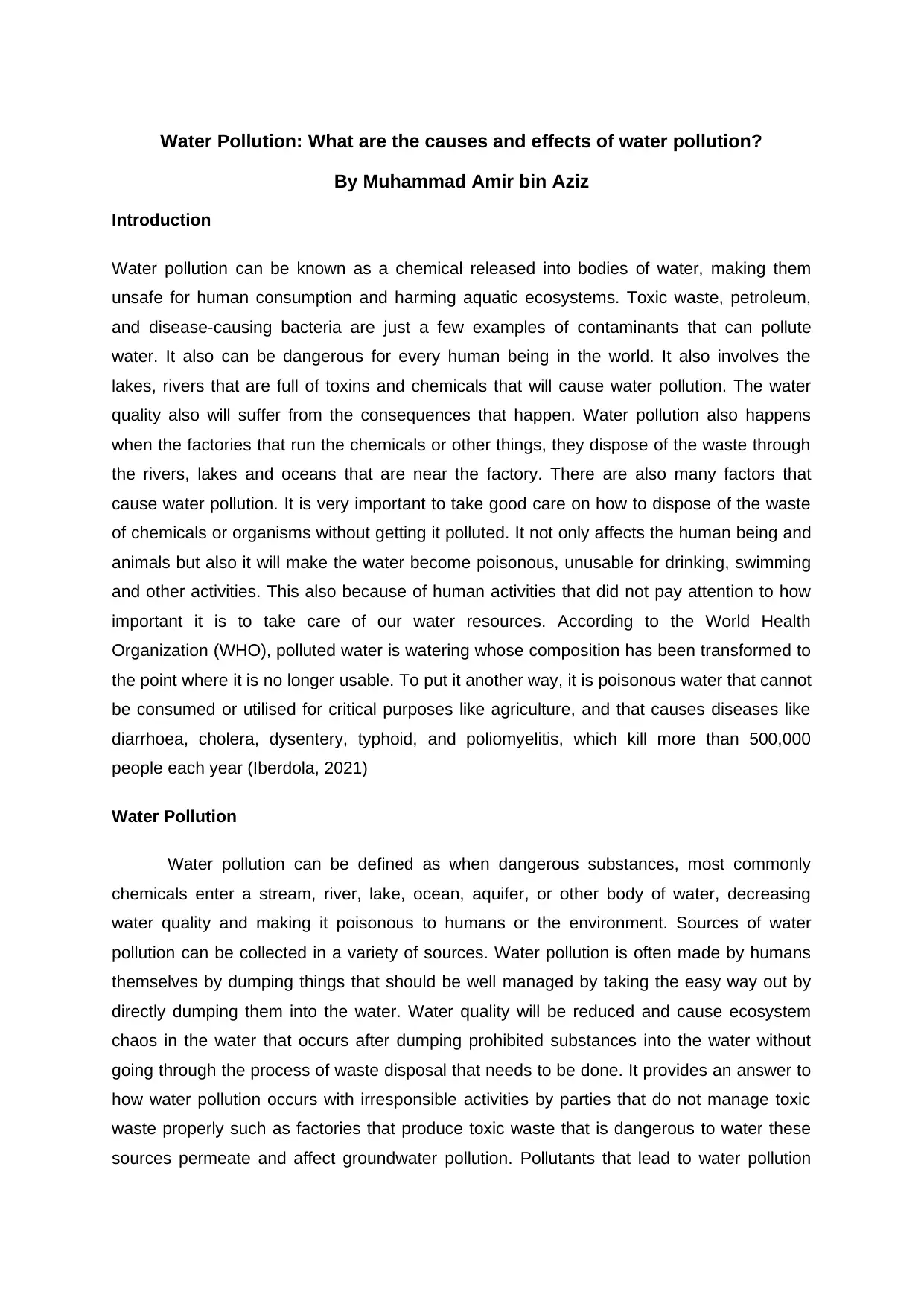
Water Pollution: What are the causes and effects of water pollution?
By Muhammad Amir bin Aziz
Introduction
Water pollution can be known as a chemical released into bodies of water, making them
unsafe for human consumption and harming aquatic ecosystems. Toxic waste, petroleum,
and disease-causing bacteria are just a few examples of contaminants that can pollute
water. It also can be dangerous for every human being in the world. It also involves the
lakes, rivers that are full of toxins and chemicals that will cause water pollution. The water
quality also will suffer from the consequences that happen. Water pollution also happens
when the factories that run the chemicals or other things, they dispose of the waste through
the rivers, lakes and oceans that are near the factory. There are also many factors that
cause water pollution. It is very important to take good care on how to dispose of the waste
of chemicals or organisms without getting it polluted. It not only affects the human being and
animals but also it will make the water become poisonous, unusable for drinking, swimming
and other activities. This also because of human activities that did not pay attention to how
important it is to take care of our water resources. According to the World Health
Organization (WHO), polluted water is watering whose composition has been transformed to
the point where it is no longer usable. To put it another way, it is poisonous water that cannot
be consumed or utilised for critical purposes like agriculture, and that causes diseases like
diarrhoea, cholera, dysentery, typhoid, and poliomyelitis, which kill more than 500,000
people each year (Iberdola, 2021)
Water Pollution
Water pollution can be defined as when dangerous substances, most commonly
chemicals enter a stream, river, lake, ocean, aquifer, or other body of water, decreasing
water quality and making it poisonous to humans or the environment. Sources of water
pollution can be collected in a variety of sources. Water pollution is often made by humans
themselves by dumping things that should be well managed by taking the easy way out by
directly dumping them into the water. Water quality will be reduced and cause ecosystem
chaos in the water that occurs after dumping prohibited substances into the water without
going through the process of waste disposal that needs to be done. It provides an answer to
how water pollution occurs with irresponsible activities by parties that do not manage toxic
waste properly such as factories that produce toxic waste that is dangerous to water these
sources permeate and affect groundwater pollution. Pollutants that lead to water pollution
By Muhammad Amir bin Aziz
Introduction
Water pollution can be known as a chemical released into bodies of water, making them
unsafe for human consumption and harming aquatic ecosystems. Toxic waste, petroleum,
and disease-causing bacteria are just a few examples of contaminants that can pollute
water. It also can be dangerous for every human being in the world. It also involves the
lakes, rivers that are full of toxins and chemicals that will cause water pollution. The water
quality also will suffer from the consequences that happen. Water pollution also happens
when the factories that run the chemicals or other things, they dispose of the waste through
the rivers, lakes and oceans that are near the factory. There are also many factors that
cause water pollution. It is very important to take good care on how to dispose of the waste
of chemicals or organisms without getting it polluted. It not only affects the human being and
animals but also it will make the water become poisonous, unusable for drinking, swimming
and other activities. This also because of human activities that did not pay attention to how
important it is to take care of our water resources. According to the World Health
Organization (WHO), polluted water is watering whose composition has been transformed to
the point where it is no longer usable. To put it another way, it is poisonous water that cannot
be consumed or utilised for critical purposes like agriculture, and that causes diseases like
diarrhoea, cholera, dysentery, typhoid, and poliomyelitis, which kill more than 500,000
people each year (Iberdola, 2021)
Water Pollution
Water pollution can be defined as when dangerous substances, most commonly
chemicals enter a stream, river, lake, ocean, aquifer, or other body of water, decreasing
water quality and making it poisonous to humans or the environment. Sources of water
pollution can be collected in a variety of sources. Water pollution is often made by humans
themselves by dumping things that should be well managed by taking the easy way out by
directly dumping them into the water. Water quality will be reduced and cause ecosystem
chaos in the water that occurs after dumping prohibited substances into the water without
going through the process of waste disposal that needs to be done. It provides an answer to
how water pollution occurs with irresponsible activities by parties that do not manage toxic
waste properly such as factories that produce toxic waste that is dangerous to water these
sources permeate and affect groundwater pollution. Pollutants that lead to water pollution
Paraphrase This Document
Need a fresh take? Get an instant paraphrase of this document with our AI Paraphraser
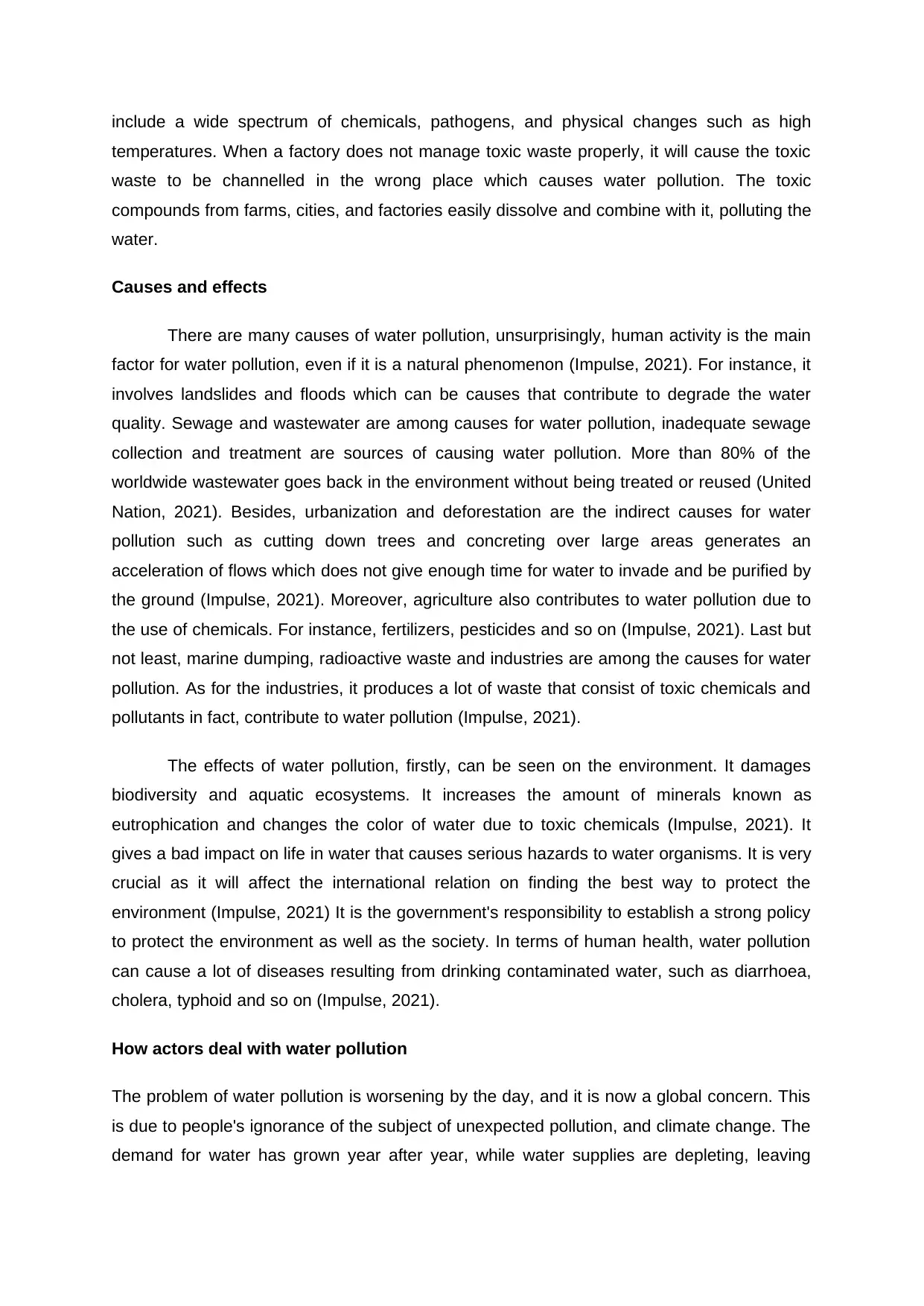
include a wide spectrum of chemicals, pathogens, and physical changes such as high
temperatures. When a factory does not manage toxic waste properly, it will cause the toxic
waste to be channelled in the wrong place which causes water pollution. The toxic
compounds from farms, cities, and factories easily dissolve and combine with it, polluting the
water.
Causes and effects
There are many causes of water pollution, unsurprisingly, human activity is the main
factor for water pollution, even if it is a natural phenomenon (Impulse, 2021). For instance, it
involves landslides and floods which can be causes that contribute to degrade the water
quality. Sewage and wastewater are among causes for water pollution, inadequate sewage
collection and treatment are sources of causing water pollution. More than 80% of the
worldwide wastewater goes back in the environment without being treated or reused (United
Nation, 2021). Besides, urbanization and deforestation are the indirect causes for water
pollution such as cutting down trees and concreting over large areas generates an
acceleration of flows which does not give enough time for water to invade and be purified by
the ground (Impulse, 2021). Moreover, agriculture also contributes to water pollution due to
the use of chemicals. For instance, fertilizers, pesticides and so on (Impulse, 2021). Last but
not least, marine dumping, radioactive waste and industries are among the causes for water
pollution. As for the industries, it produces a lot of waste that consist of toxic chemicals and
pollutants in fact, contribute to water pollution (Impulse, 2021).
The effects of water pollution, firstly, can be seen on the environment. It damages
biodiversity and aquatic ecosystems. It increases the amount of minerals known as
eutrophication and changes the color of water due to toxic chemicals (Impulse, 2021). It
gives a bad impact on life in water that causes serious hazards to water organisms. It is very
crucial as it will affect the international relation on finding the best way to protect the
environment (Impulse, 2021) It is the government's responsibility to establish a strong policy
to protect the environment as well as the society. In terms of human health, water pollution
can cause a lot of diseases resulting from drinking contaminated water, such as diarrhoea,
cholera, typhoid and so on (Impulse, 2021).
How actors deal with water pollution
The problem of water pollution is worsening by the day, and it is now a global concern. This
is due to people's ignorance of the subject of unexpected pollution, and climate change. The
demand for water has grown year after year, while water supplies are depleting, leaving
temperatures. When a factory does not manage toxic waste properly, it will cause the toxic
waste to be channelled in the wrong place which causes water pollution. The toxic
compounds from farms, cities, and factories easily dissolve and combine with it, polluting the
water.
Causes and effects
There are many causes of water pollution, unsurprisingly, human activity is the main
factor for water pollution, even if it is a natural phenomenon (Impulse, 2021). For instance, it
involves landslides and floods which can be causes that contribute to degrade the water
quality. Sewage and wastewater are among causes for water pollution, inadequate sewage
collection and treatment are sources of causing water pollution. More than 80% of the
worldwide wastewater goes back in the environment without being treated or reused (United
Nation, 2021). Besides, urbanization and deforestation are the indirect causes for water
pollution such as cutting down trees and concreting over large areas generates an
acceleration of flows which does not give enough time for water to invade and be purified by
the ground (Impulse, 2021). Moreover, agriculture also contributes to water pollution due to
the use of chemicals. For instance, fertilizers, pesticides and so on (Impulse, 2021). Last but
not least, marine dumping, radioactive waste and industries are among the causes for water
pollution. As for the industries, it produces a lot of waste that consist of toxic chemicals and
pollutants in fact, contribute to water pollution (Impulse, 2021).
The effects of water pollution, firstly, can be seen on the environment. It damages
biodiversity and aquatic ecosystems. It increases the amount of minerals known as
eutrophication and changes the color of water due to toxic chemicals (Impulse, 2021). It
gives a bad impact on life in water that causes serious hazards to water organisms. It is very
crucial as it will affect the international relation on finding the best way to protect the
environment (Impulse, 2021) It is the government's responsibility to establish a strong policy
to protect the environment as well as the society. In terms of human health, water pollution
can cause a lot of diseases resulting from drinking contaminated water, such as diarrhoea,
cholera, typhoid and so on (Impulse, 2021).
How actors deal with water pollution
The problem of water pollution is worsening by the day, and it is now a global concern. This
is due to people's ignorance of the subject of unexpected pollution, and climate change. The
demand for water has grown year after year, while water supplies are depleting, leaving
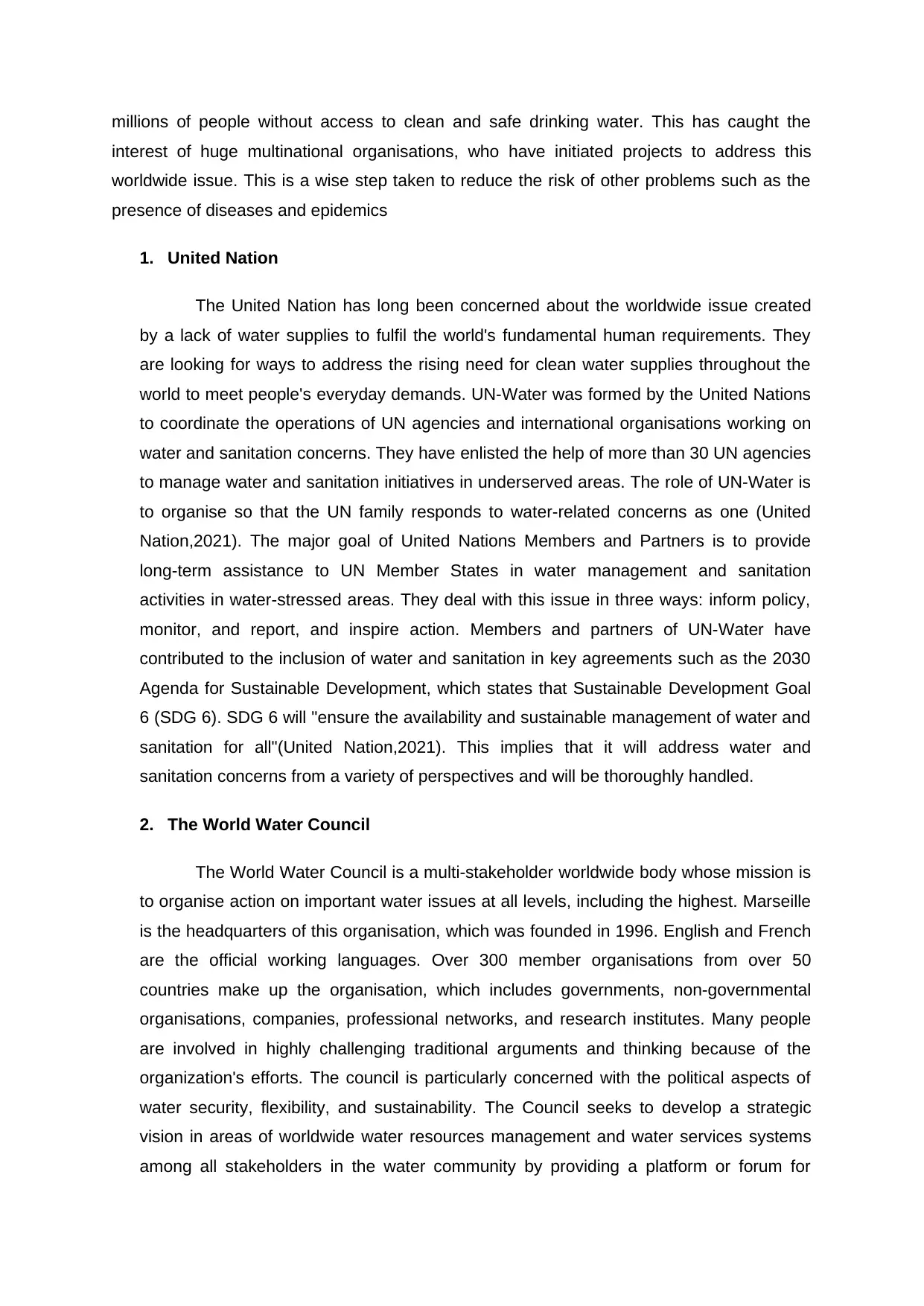
millions of people without access to clean and safe drinking water. This has caught the
interest of huge multinational organisations, who have initiated projects to address this
worldwide issue. This is a wise step taken to reduce the risk of other problems such as the
presence of diseases and epidemics
1. United Nation
The United Nation has long been concerned about the worldwide issue created
by a lack of water supplies to fulfil the world's fundamental human requirements. They
are looking for ways to address the rising need for clean water supplies throughout the
world to meet people's everyday demands. UN-Water was formed by the United Nations
to coordinate the operations of UN agencies and international organisations working on
water and sanitation concerns. They have enlisted the help of more than 30 UN agencies
to manage water and sanitation initiatives in underserved areas. The role of UN-Water is
to organise so that the UN family responds to water-related concerns as one (United
Nation,2021). The major goal of United Nations Members and Partners is to provide
long-term assistance to UN Member States in water management and sanitation
activities in water-stressed areas. They deal with this issue in three ways: inform policy,
monitor, and report, and inspire action. Members and partners of UN-Water have
contributed to the inclusion of water and sanitation in key agreements such as the 2030
Agenda for Sustainable Development, which states that Sustainable Development Goal
6 (SDG 6). SDG 6 will "ensure the availability and sustainable management of water and
sanitation for all"(United Nation,2021). This implies that it will address water and
sanitation concerns from a variety of perspectives and will be thoroughly handled.
2. The World Water Council
The World Water Council is a multi-stakeholder worldwide body whose mission is
to organise action on important water issues at all levels, including the highest. Marseille
is the headquarters of this organisation, which was founded in 1996. English and French
are the official working languages. Over 300 member organisations from over 50
countries make up the organisation, which includes governments, non-governmental
organisations, companies, professional networks, and research institutes. Many people
are involved in highly challenging traditional arguments and thinking because of the
organization's efforts. The council is particularly concerned with the political aspects of
water security, flexibility, and sustainability. The Council seeks to develop a strategic
vision in areas of worldwide water resources management and water services systems
among all stakeholders in the water community by providing a platform or forum for
interest of huge multinational organisations, who have initiated projects to address this
worldwide issue. This is a wise step taken to reduce the risk of other problems such as the
presence of diseases and epidemics
1. United Nation
The United Nation has long been concerned about the worldwide issue created
by a lack of water supplies to fulfil the world's fundamental human requirements. They
are looking for ways to address the rising need for clean water supplies throughout the
world to meet people's everyday demands. UN-Water was formed by the United Nations
to coordinate the operations of UN agencies and international organisations working on
water and sanitation concerns. They have enlisted the help of more than 30 UN agencies
to manage water and sanitation initiatives in underserved areas. The role of UN-Water is
to organise so that the UN family responds to water-related concerns as one (United
Nation,2021). The major goal of United Nations Members and Partners is to provide
long-term assistance to UN Member States in water management and sanitation
activities in water-stressed areas. They deal with this issue in three ways: inform policy,
monitor, and report, and inspire action. Members and partners of UN-Water have
contributed to the inclusion of water and sanitation in key agreements such as the 2030
Agenda for Sustainable Development, which states that Sustainable Development Goal
6 (SDG 6). SDG 6 will "ensure the availability and sustainable management of water and
sanitation for all"(United Nation,2021). This implies that it will address water and
sanitation concerns from a variety of perspectives and will be thoroughly handled.
2. The World Water Council
The World Water Council is a multi-stakeholder worldwide body whose mission is
to organise action on important water issues at all levels, including the highest. Marseille
is the headquarters of this organisation, which was founded in 1996. English and French
are the official working languages. Over 300 member organisations from over 50
countries make up the organisation, which includes governments, non-governmental
organisations, companies, professional networks, and research institutes. Many people
are involved in highly challenging traditional arguments and thinking because of the
organization's efforts. The council is particularly concerned with the political aspects of
water security, flexibility, and sustainability. The Council seeks to develop a strategic
vision in areas of worldwide water resources management and water services systems
among all stakeholders in the water community by providing a platform or forum for
⊘ This is a preview!⊘
Do you want full access?
Subscribe today to unlock all pages.

Trusted by 1+ million students worldwide
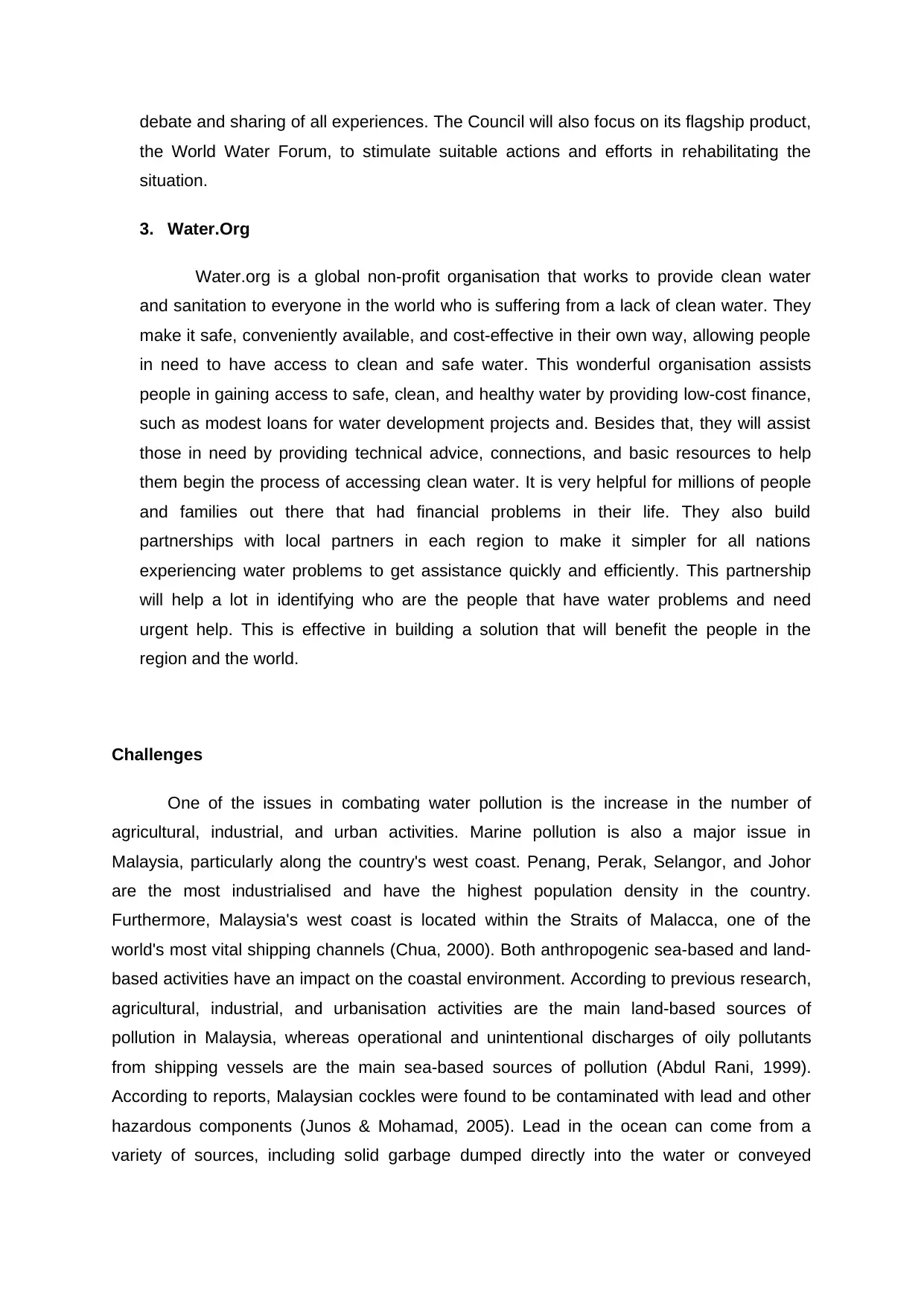
debate and sharing of all experiences. The Council will also focus on its flagship product,
the World Water Forum, to stimulate suitable actions and efforts in rehabilitating the
situation.
3. Water.Org
Water.org is a global non-profit organisation that works to provide clean water
and sanitation to everyone in the world who is suffering from a lack of clean water. They
make it safe, conveniently available, and cost-effective in their own way, allowing people
in need to have access to clean and safe water. This wonderful organisation assists
people in gaining access to safe, clean, and healthy water by providing low-cost finance,
such as modest loans for water development projects and. Besides that, they will assist
those in need by providing technical advice, connections, and basic resources to help
them begin the process of accessing clean water. It is very helpful for millions of people
and families out there that had financial problems in their life. They also build
partnerships with local partners in each region to make it simpler for all nations
experiencing water problems to get assistance quickly and efficiently. This partnership
will help a lot in identifying who are the people that have water problems and need
urgent help. This is effective in building a solution that will benefit the people in the
region and the world.
Challenges
One of the issues in combating water pollution is the increase in the number of
agricultural, industrial, and urban activities. Marine pollution is also a major issue in
Malaysia, particularly along the country's west coast. Penang, Perak, Selangor, and Johor
are the most industrialised and have the highest population density in the country.
Furthermore, Malaysia's west coast is located within the Straits of Malacca, one of the
world's most vital shipping channels (Chua, 2000). Both anthropogenic sea-based and land-
based activities have an impact on the coastal environment. According to previous research,
agricultural, industrial, and urbanisation activities are the main land-based sources of
pollution in Malaysia, whereas operational and unintentional discharges of oily pollutants
from shipping vessels are the main sea-based sources of pollution (Abdul Rani, 1999).
According to reports, Malaysian cockles were found to be contaminated with lead and other
hazardous components (Junos & Mohamad, 2005). Lead in the ocean can come from a
variety of sources, including solid garbage dumped directly into the water or conveyed
the World Water Forum, to stimulate suitable actions and efforts in rehabilitating the
situation.
3. Water.Org
Water.org is a global non-profit organisation that works to provide clean water
and sanitation to everyone in the world who is suffering from a lack of clean water. They
make it safe, conveniently available, and cost-effective in their own way, allowing people
in need to have access to clean and safe water. This wonderful organisation assists
people in gaining access to safe, clean, and healthy water by providing low-cost finance,
such as modest loans for water development projects and. Besides that, they will assist
those in need by providing technical advice, connections, and basic resources to help
them begin the process of accessing clean water. It is very helpful for millions of people
and families out there that had financial problems in their life. They also build
partnerships with local partners in each region to make it simpler for all nations
experiencing water problems to get assistance quickly and efficiently. This partnership
will help a lot in identifying who are the people that have water problems and need
urgent help. This is effective in building a solution that will benefit the people in the
region and the world.
Challenges
One of the issues in combating water pollution is the increase in the number of
agricultural, industrial, and urban activities. Marine pollution is also a major issue in
Malaysia, particularly along the country's west coast. Penang, Perak, Selangor, and Johor
are the most industrialised and have the highest population density in the country.
Furthermore, Malaysia's west coast is located within the Straits of Malacca, one of the
world's most vital shipping channels (Chua, 2000). Both anthropogenic sea-based and land-
based activities have an impact on the coastal environment. According to previous research,
agricultural, industrial, and urbanisation activities are the main land-based sources of
pollution in Malaysia, whereas operational and unintentional discharges of oily pollutants
from shipping vessels are the main sea-based sources of pollution (Abdul Rani, 1999).
According to reports, Malaysian cockles were found to be contaminated with lead and other
hazardous components (Junos & Mohamad, 2005). Lead in the ocean can come from a
variety of sources, including solid garbage dumped directly into the water or conveyed
Paraphrase This Document
Need a fresh take? Get an instant paraphrase of this document with our AI Paraphraser
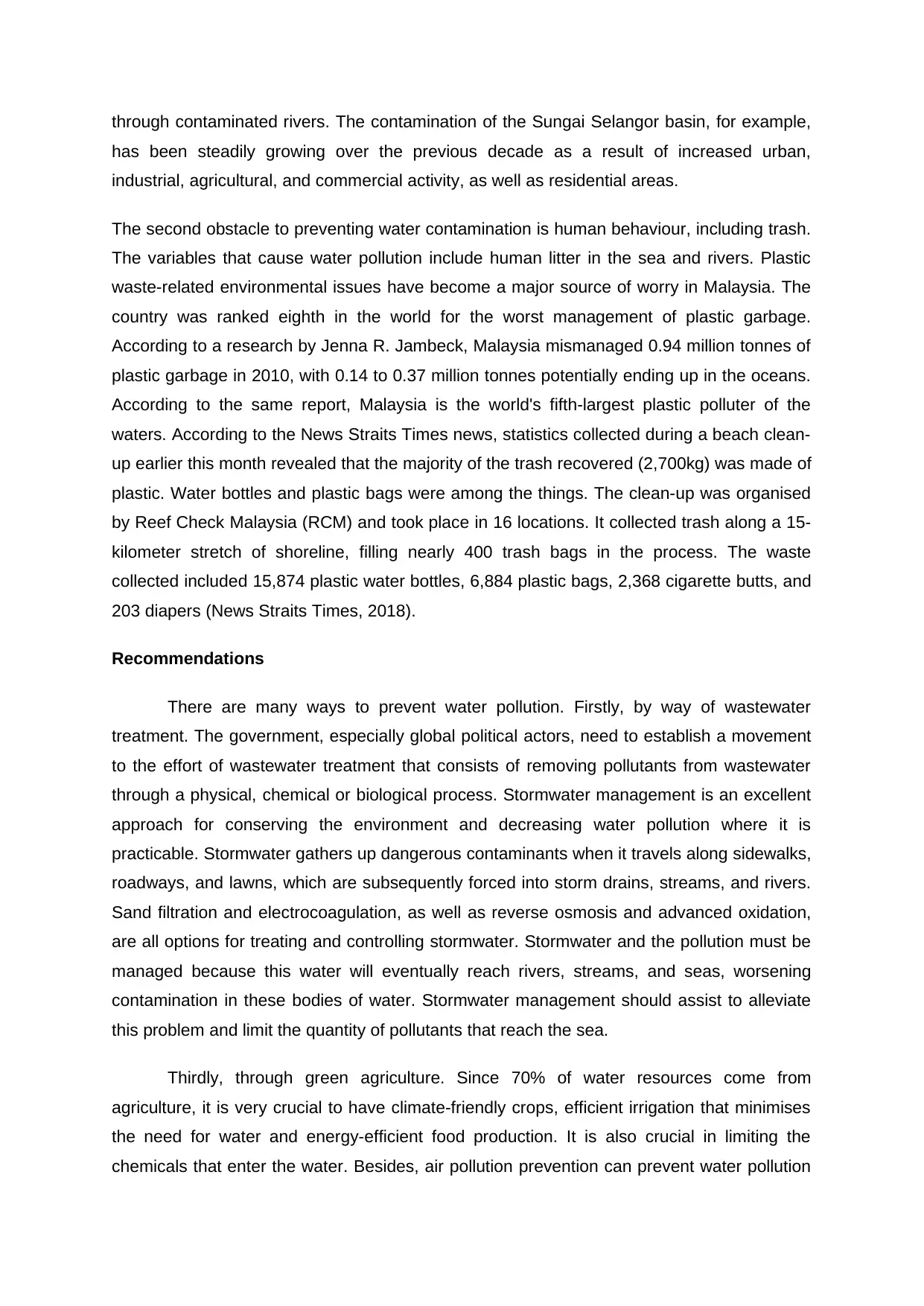
through contaminated rivers. The contamination of the Sungai Selangor basin, for example,
has been steadily growing over the previous decade as a result of increased urban,
industrial, agricultural, and commercial activity, as well as residential areas.
The second obstacle to preventing water contamination is human behaviour, including trash.
The variables that cause water pollution include human litter in the sea and rivers. Plastic
waste-related environmental issues have become a major source of worry in Malaysia. The
country was ranked eighth in the world for the worst management of plastic garbage.
According to a research by Jenna R. Jambeck, Malaysia mismanaged 0.94 million tonnes of
plastic garbage in 2010, with 0.14 to 0.37 million tonnes potentially ending up in the oceans.
According to the same report, Malaysia is the world's fifth-largest plastic polluter of the
waters. According to the News Straits Times news, statistics collected during a beach clean-
up earlier this month revealed that the majority of the trash recovered (2,700kg) was made of
plastic. Water bottles and plastic bags were among the things. The clean-up was organised
by Reef Check Malaysia (RCM) and took place in 16 locations. It collected trash along a 15-
kilometer stretch of shoreline, filling nearly 400 trash bags in the process. The waste
collected included 15,874 plastic water bottles, 6,884 plastic bags, 2,368 cigarette butts, and
203 diapers (News Straits Times, 2018).
Recommendations
There are many ways to prevent water pollution. Firstly, by way of wastewater
treatment. The government, especially global political actors, need to establish a movement
to the effort of wastewater treatment that consists of removing pollutants from wastewater
through a physical, chemical or biological process. Stormwater management is an excellent
approach for conserving the environment and decreasing water pollution where it is
practicable. Stormwater gathers up dangerous contaminants when it travels along sidewalks,
roadways, and lawns, which are subsequently forced into storm drains, streams, and rivers.
Sand filtration and electrocoagulation, as well as reverse osmosis and advanced oxidation,
are all options for treating and controlling stormwater. Stormwater and the pollution must be
managed because this water will eventually reach rivers, streams, and seas, worsening
contamination in these bodies of water. Stormwater management should assist to alleviate
this problem and limit the quantity of pollutants that reach the sea.
Thirdly, through green agriculture. Since 70% of water resources come from
agriculture, it is very crucial to have climate-friendly crops, efficient irrigation that minimises
the need for water and energy-efficient food production. It is also crucial in limiting the
chemicals that enter the water. Besides, air pollution prevention can prevent water pollution
has been steadily growing over the previous decade as a result of increased urban,
industrial, agricultural, and commercial activity, as well as residential areas.
The second obstacle to preventing water contamination is human behaviour, including trash.
The variables that cause water pollution include human litter in the sea and rivers. Plastic
waste-related environmental issues have become a major source of worry in Malaysia. The
country was ranked eighth in the world for the worst management of plastic garbage.
According to a research by Jenna R. Jambeck, Malaysia mismanaged 0.94 million tonnes of
plastic garbage in 2010, with 0.14 to 0.37 million tonnes potentially ending up in the oceans.
According to the same report, Malaysia is the world's fifth-largest plastic polluter of the
waters. According to the News Straits Times news, statistics collected during a beach clean-
up earlier this month revealed that the majority of the trash recovered (2,700kg) was made of
plastic. Water bottles and plastic bags were among the things. The clean-up was organised
by Reef Check Malaysia (RCM) and took place in 16 locations. It collected trash along a 15-
kilometer stretch of shoreline, filling nearly 400 trash bags in the process. The waste
collected included 15,874 plastic water bottles, 6,884 plastic bags, 2,368 cigarette butts, and
203 diapers (News Straits Times, 2018).
Recommendations
There are many ways to prevent water pollution. Firstly, by way of wastewater
treatment. The government, especially global political actors, need to establish a movement
to the effort of wastewater treatment that consists of removing pollutants from wastewater
through a physical, chemical or biological process. Stormwater management is an excellent
approach for conserving the environment and decreasing water pollution where it is
practicable. Stormwater gathers up dangerous contaminants when it travels along sidewalks,
roadways, and lawns, which are subsequently forced into storm drains, streams, and rivers.
Sand filtration and electrocoagulation, as well as reverse osmosis and advanced oxidation,
are all options for treating and controlling stormwater. Stormwater and the pollution must be
managed because this water will eventually reach rivers, streams, and seas, worsening
contamination in these bodies of water. Stormwater management should assist to alleviate
this problem and limit the quantity of pollutants that reach the sea.
Thirdly, through green agriculture. Since 70% of water resources come from
agriculture, it is very crucial to have climate-friendly crops, efficient irrigation that minimises
the need for water and energy-efficient food production. It is also crucial in limiting the
chemicals that enter the water. Besides, air pollution prevention can prevent water pollution
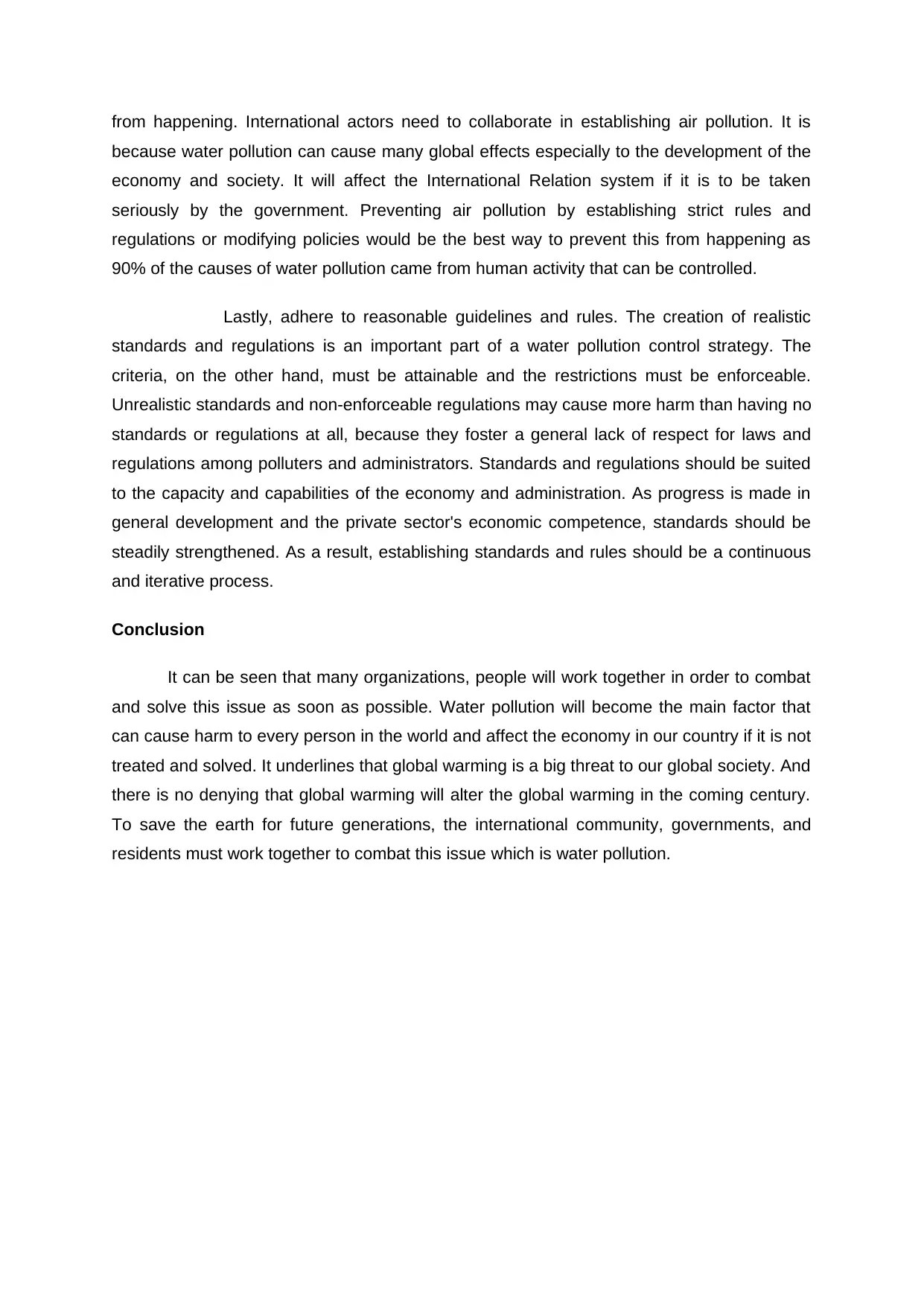
from happening. International actors need to collaborate in establishing air pollution. It is
because water pollution can cause many global effects especially to the development of the
economy and society. It will affect the International Relation system if it is to be taken
seriously by the government. Preventing air pollution by establishing strict rules and
regulations or modifying policies would be the best way to prevent this from happening as
90% of the causes of water pollution came from human activity that can be controlled.
Lastly, adhere to reasonable guidelines and rules. The creation of realistic
standards and regulations is an important part of a water pollution control strategy. The
criteria, on the other hand, must be attainable and the restrictions must be enforceable.
Unrealistic standards and non-enforceable regulations may cause more harm than having no
standards or regulations at all, because they foster a general lack of respect for laws and
regulations among polluters and administrators. Standards and regulations should be suited
to the capacity and capabilities of the economy and administration. As progress is made in
general development and the private sector's economic competence, standards should be
steadily strengthened. As a result, establishing standards and rules should be a continuous
and iterative process.
Conclusion
It can be seen that many organizations, people will work together in order to combat
and solve this issue as soon as possible. Water pollution will become the main factor that
can cause harm to every person in the world and affect the economy in our country if it is not
treated and solved. It underlines that global warming is a big threat to our global society. And
there is no denying that global warming will alter the global warming in the coming century.
To save the earth for future generations, the international community, governments, and
residents must work together to combat this issue which is water pollution.
because water pollution can cause many global effects especially to the development of the
economy and society. It will affect the International Relation system if it is to be taken
seriously by the government. Preventing air pollution by establishing strict rules and
regulations or modifying policies would be the best way to prevent this from happening as
90% of the causes of water pollution came from human activity that can be controlled.
Lastly, adhere to reasonable guidelines and rules. The creation of realistic
standards and regulations is an important part of a water pollution control strategy. The
criteria, on the other hand, must be attainable and the restrictions must be enforceable.
Unrealistic standards and non-enforceable regulations may cause more harm than having no
standards or regulations at all, because they foster a general lack of respect for laws and
regulations among polluters and administrators. Standards and regulations should be suited
to the capacity and capabilities of the economy and administration. As progress is made in
general development and the private sector's economic competence, standards should be
steadily strengthened. As a result, establishing standards and rules should be a continuous
and iterative process.
Conclusion
It can be seen that many organizations, people will work together in order to combat
and solve this issue as soon as possible. Water pollution will become the main factor that
can cause harm to every person in the world and affect the economy in our country if it is not
treated and solved. It underlines that global warming is a big threat to our global society. And
there is no denying that global warming will alter the global warming in the coming century.
To save the earth for future generations, the international community, governments, and
residents must work together to combat this issue which is water pollution.
⊘ This is a preview!⊘
Do you want full access?
Subscribe today to unlock all pages.

Trusted by 1+ million students worldwide
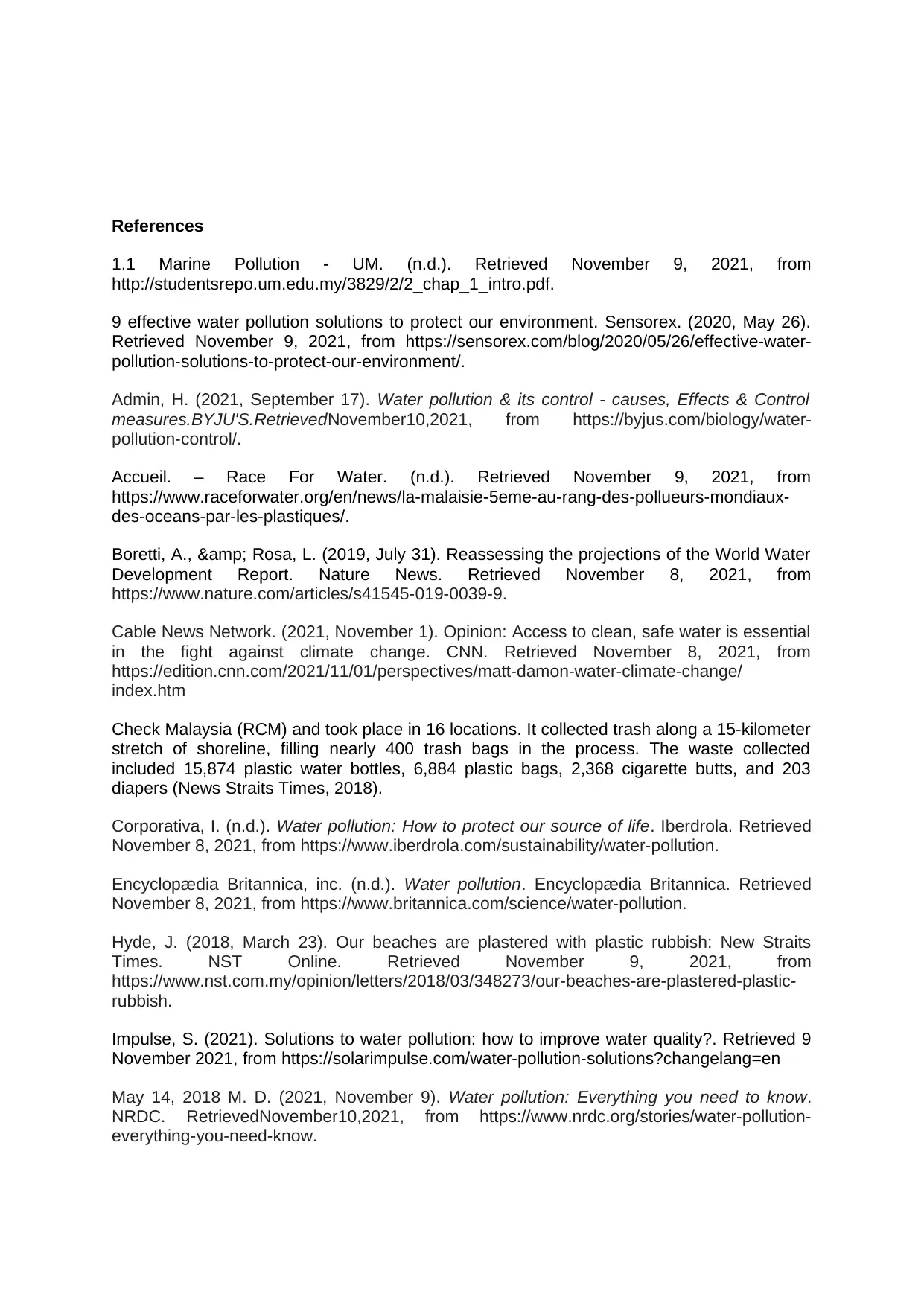
References
1.1 Marine Pollution - UM. (n.d.). Retrieved November 9, 2021, from
http://studentsrepo.um.edu.my/3829/2/2_chap_1_intro.pdf.
9 effective water pollution solutions to protect our environment. Sensorex. (2020, May 26).
Retrieved November 9, 2021, from https://sensorex.com/blog/2020/05/26/effective-water-
pollution-solutions-to-protect-our-environment/.
Admin, H. (2021, September 17). Water pollution & its control - causes, Effects & Control
measures.BYJU'S.RetrievedNovember10,2021, from https://byjus.com/biology/water-
pollution-control/.
Accueil. – Race For Water. (n.d.). Retrieved November 9, 2021, from
https://www.raceforwater.org/en/news/la-malaisie-5eme-au-rang-des-pollueurs-mondiaux-
des-oceans-par-les-plastiques/.
Boretti, A., & Rosa, L. (2019, July 31). Reassessing the projections of the World Water
Development Report. Nature News. Retrieved November 8, 2021, from
https://www.nature.com/articles/s41545-019-0039-9.
Cable News Network. (2021, November 1). Opinion: Access to clean, safe water is essential
in the fight against climate change. CNN. Retrieved November 8, 2021, from
https://edition.cnn.com/2021/11/01/perspectives/matt-damon-water-climate-change/
index.htm
Check Malaysia (RCM) and took place in 16 locations. It collected trash along a 15-kilometer
stretch of shoreline, filling nearly 400 trash bags in the process. The waste collected
included 15,874 plastic water bottles, 6,884 plastic bags, 2,368 cigarette butts, and 203
diapers (News Straits Times, 2018).
Corporativa, I. (n.d.). Water pollution: How to protect our source of life. Iberdrola. Retrieved
November 8, 2021, from https://www.iberdrola.com/sustainability/water-pollution.
Encyclopædia Britannica, inc. (n.d.). Water pollution. Encyclopædia Britannica. Retrieved
November 8, 2021, from https://www.britannica.com/science/water-pollution.
Hyde, J. (2018, March 23). Our beaches are plastered with plastic rubbish: New Straits
Times. NST Online. Retrieved November 9, 2021, from
https://www.nst.com.my/opinion/letters/2018/03/348273/our-beaches-are-plastered-plastic-
rubbish.
Impulse, S. (2021). Solutions to water pollution: how to improve water quality?. Retrieved 9
November 2021, from https://solarimpulse.com/water-pollution-solutions?changelang=en
May 14, 2018 M. D. (2021, November 9). Water pollution: Everything you need to know.
NRDC. RetrievedNovember10,2021, from https://www.nrdc.org/stories/water-pollution-
everything-you-need-know.
1.1 Marine Pollution - UM. (n.d.). Retrieved November 9, 2021, from
http://studentsrepo.um.edu.my/3829/2/2_chap_1_intro.pdf.
9 effective water pollution solutions to protect our environment. Sensorex. (2020, May 26).
Retrieved November 9, 2021, from https://sensorex.com/blog/2020/05/26/effective-water-
pollution-solutions-to-protect-our-environment/.
Admin, H. (2021, September 17). Water pollution & its control - causes, Effects & Control
measures.BYJU'S.RetrievedNovember10,2021, from https://byjus.com/biology/water-
pollution-control/.
Accueil. – Race For Water. (n.d.). Retrieved November 9, 2021, from
https://www.raceforwater.org/en/news/la-malaisie-5eme-au-rang-des-pollueurs-mondiaux-
des-oceans-par-les-plastiques/.
Boretti, A., & Rosa, L. (2019, July 31). Reassessing the projections of the World Water
Development Report. Nature News. Retrieved November 8, 2021, from
https://www.nature.com/articles/s41545-019-0039-9.
Cable News Network. (2021, November 1). Opinion: Access to clean, safe water is essential
in the fight against climate change. CNN. Retrieved November 8, 2021, from
https://edition.cnn.com/2021/11/01/perspectives/matt-damon-water-climate-change/
index.htm
Check Malaysia (RCM) and took place in 16 locations. It collected trash along a 15-kilometer
stretch of shoreline, filling nearly 400 trash bags in the process. The waste collected
included 15,874 plastic water bottles, 6,884 plastic bags, 2,368 cigarette butts, and 203
diapers (News Straits Times, 2018).
Corporativa, I. (n.d.). Water pollution: How to protect our source of life. Iberdrola. Retrieved
November 8, 2021, from https://www.iberdrola.com/sustainability/water-pollution.
Encyclopædia Britannica, inc. (n.d.). Water pollution. Encyclopædia Britannica. Retrieved
November 8, 2021, from https://www.britannica.com/science/water-pollution.
Hyde, J. (2018, March 23). Our beaches are plastered with plastic rubbish: New Straits
Times. NST Online. Retrieved November 9, 2021, from
https://www.nst.com.my/opinion/letters/2018/03/348273/our-beaches-are-plastered-plastic-
rubbish.
Impulse, S. (2021). Solutions to water pollution: how to improve water quality?. Retrieved 9
November 2021, from https://solarimpulse.com/water-pollution-solutions?changelang=en
May 14, 2018 M. D. (2021, November 9). Water pollution: Everything you need to know.
NRDC. RetrievedNovember10,2021, from https://www.nrdc.org/stories/water-pollution-
everything-you-need-know.
Paraphrase This Document
Need a fresh take? Get an instant paraphrase of this document with our AI Paraphraser

Water pollution control - a guide to the use of water ... (n.d.). Retrieved November 9, 2021,
from https://www.who.int/water_sanitation_health/resourcesquality/watpolcontrol.pdf.
White, G. F. (2009, August 24). Proposed world water council: Environmental conservation.
Cambridge Core. Retrieved November 8, 2021, from
https://www.cambridge.org/core/journals/environmental-conservation/article/proposed-world-
water-council/A16A5329B082ABC07A3FA713533BCF67.
from https://www.who.int/water_sanitation_health/resourcesquality/watpolcontrol.pdf.
White, G. F. (2009, August 24). Proposed world water council: Environmental conservation.
Cambridge Core. Retrieved November 8, 2021, from
https://www.cambridge.org/core/journals/environmental-conservation/article/proposed-world-
water-council/A16A5329B082ABC07A3FA713533BCF67.
1 out of 8
Related Documents
Your All-in-One AI-Powered Toolkit for Academic Success.
+13062052269
info@desklib.com
Available 24*7 on WhatsApp / Email
![[object Object]](/_next/static/media/star-bottom.7253800d.svg)
Unlock your academic potential
Copyright © 2020–2025 A2Z Services. All Rights Reserved. Developed and managed by ZUCOL.





